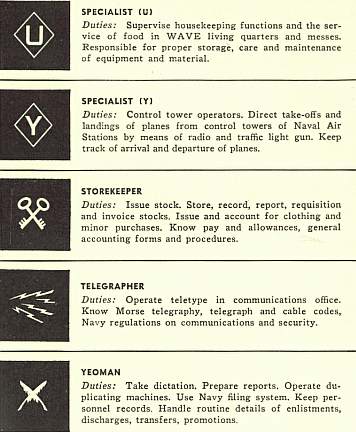|
Facts about the WAVES
.
Types of Duty and Duty Stations
Types of Duty
Here are examples of jobs that WAVES handled
as well as Navy men.
.

.

.

.

.
Duty Stations
The Chief of Naval Operations, Admiral Ernest J. King, exercised
his command responsibilities over activities ashore through the area commanders.
There were 14 naval districts. District commandants exercised direct military
command over naval bases and naval air bases located within their area
commands. WAVES served on all naval bases and air bases within the United
States, and many naval and air bases in the Caribbean, Atlantic and western
Pacific zones such as the Territories of Alaska and Hawaii.
| First Naval District |
495 Summer Street, Boston 10, Massachusetts |
| Second Naval District |
located in Newport, R. I., but this district
was abolished in 1919 |
| Third Naval District |
90 Church Street, New York 7, New York |
| Fourth Naval District |
Naval Base Station, Philadelphia 12, Pennsylvania |
| Fifth Naval District |
Naval Station, Norfolk 11, Virginia |
| Sixth Naval District |
Building 4, Naval Base, Charleston, South
Carolina |
| Seventh Naval District |
Naval Air Station, Jacksonville, Florida (absorbed
by the Sixth Naval District in 1948) |
| Eighth Naval District |
New Federal Building, New Orleans 12, Louisiana |
| Ninth Naval District |
Administrative Building, Great Lakes Naval
Training Center, Illinois |
| Tenth Naval District |
San Juan, Puerto Rico |
| Eleventh Naval District |
Navy Headquarters Building, San Diego, California |
| Twelfth Naval District |
Federal Building, San Francisco 2, California |
| Thirteenth Naval District |
Naval Station, Seattle 99, Washington |
| Fourteenth Naval District |
Administrative Building, United States Naval
Base, Pearl Harbor, Hawaii |
| Fifteenth Naval District |
Balboa, Canal Zone |
| Sixteenth Naval District |
Cavite, Philippine Islands (not revived after
World War II) |
| Seventeenth Naval District |
Kodiak, Alaska |
..
Payment
The WAVES initially did not the same allowances
or benefits permitted for male officers and sailors. Nevertheless, later
legislation was passed in 1943 that gave WAVES almost equal compensation
and other benefits (although not fully equalized until after the war).
Legislative amendments also permitted WAVES to serve beyond the stateside
United States at certain stations in the US Territories (i.e., Alaska and
Hawaii) and overseas.
Moreover, there was extra pay to cover living
expenses: food, comfortable quarters, medical and dental care, and clothing.
When government facilities were not available, WAVES received an additional
supplement to their pay, subsistence and quarter allowances totaling $2.75
a day. There were benefits prescribed by law for civil employees if suffering
disability or death caused by disease or injury while on active duty. Life
insurance at low government rates, privileges of free mail, reduced rates
on transportation, movie and theatre tickets, and benefits from organizations
such as the USO, Red Cross and Navy Relief gave advantageous incentives.
..
.
[
I. Development ] [ II. Facts
about the WAVES ] [
III. Uniforms ] [ IV. Sources ]
|
